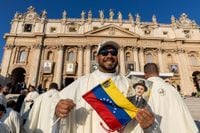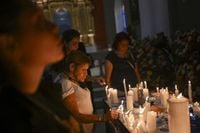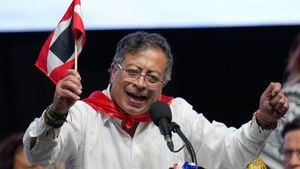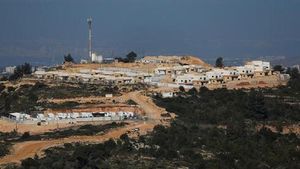Vatican City was awash in color and emotion on October 19, 2025, as Pope Leo XIV canonized seven new saints, offering a beacon of hope to nations and communities across the globe. Among them, Venezuela’s José Gregorio Hernández, affectionately known as the “doctor of the poor,” became the country’s first-ever saint—a moment that sparked jubilation both in Rome and back home in Caracas. The canonization, attended by approximately 70,000 faithful in St. Peter’s Square and watched by thousands more in Venezuela, marked a rare moment of national pride for a country battered by economic crisis and political turmoil.
The ceremony, held on World Mission Day, was not only a religious milestone but also a deeply symbolic event for millions of Venezuelans. Hernández, a physician in Caracas during the late 19th and early 20th centuries, was renowned for his selfless service to the poor. He often refused payment from those unable to afford care, sometimes reaching into his own pocket to buy medicine for patients. Tragically, his life was cut short in 1919 when he was fatally struck by a car while delivering medicine to an elderly woman in need. Yet, his legacy only grew after his death, transforming him into a national icon whose image now graces murals, hospital walls, and countless home altars throughout Venezuela.
“It’s good news after so much sadness,” said Ana Sanabria, a 71-year-old homemaker in Caracas, as fireworks lit up the night sky following the Mass. According to the Associated Press, the celebration in Venezuela’s capital drew crowds who gathered outside the Nuestra Señora de La Candelaria church, where a towering statue of Hernández stands. They watched the Vatican ceremony on a giant screen, their faces painted with hope and pride after years of hardship.
Back in St. Peter’s Square, Venezuelan flags draped over police barricades provided a striking contrast to the Swiss Guards’ uniforms, and the excitement was palpable. For many Venezuelans, the canonization was the culmination of decades of devotion and petition. When Pope John Paul II visited Venezuela in 1996, he received a petition signed by five million people—nearly a quarter of the country’s population—asking for Hernández to be declared a saint. Silvia Correale, who championed his sainthood cause, told the Associated Press, “Certainly, the canonization of José Gregorio is desired by all the Venezuelan people, and has been waited for by all the people.”
José Ramon Malavecontreras, a Venezuelan living in Rome, echoed this sentiment. “They believed I’d be stillborn, so [my mother] dedicated his name to me for saving my life,” he said. “Therefore, this moment was unmissable for me. I couldn’t fail to be here.”
The road to sainthood is typically long and arduous, requiring proof of at least two miracles, evidence of an exemplary Christian life, and a waiting period of five years after death. However, in Hernández’s case, Pope Francis—who approved the canonization from his hospital room on February 24, 2025—chose to bypass the traditional miracle confirmation process. Citing the “widespread veneration of the ‘doctor-saint’ among the faithful,” Francis’s decision underscored the deep connection between Hernández and the Venezuelan people. As the Vatican explained, this rare exception was made due to the overwhelming devotion surrounding Hernández’s legacy.
Venezuelan President Nicolás Maduro was quick to express his gratitude. In remarks following the Mass, he said, “Today we have raised a prayer for the eternal spirit of he who is going to be a saint, also for Pope Francis, who gave this beautiful gift to Venezuela.” For many, the canonization provided a much-needed respite from the country’s ongoing struggles. Venezuela’s economy has been in crisis for over a decade, worsened by U.S. sanctions and government mismanagement. As reported by the Associated Press, 80% of the population now lives in poverty, and millions have emigrated in search of better opportunities.
The timing of the canonization was especially poignant. Just weeks earlier, opposition leader María Corina Machado won the Nobel Peace Prize, and tensions with the United States escalated after President Donald Trump confirmed he had authorized CIA covert operations in Venezuela—an admission that sent shockwaves through the region. Against this backdrop, the canonization offered a rare moment of unity and celebration for Venezuelans of all backgrounds.
But Venezuela was not the only nation to celebrate. The ceremony also brought joy to Papua New Guinea, which saw its first saint, Peter To Rot, recognized for his steadfast defense of Christian marriage and faith during the Japanese occupation in World War II. To Rot was martyred in 1945 for defying laws that permitted polygamy and for continuing to catechize his fellow villagers in secret. His courage and conviction resonated far beyond his homeland, making his canonization a powerful testament to the global reach of faith.
Other newly canonized saints included Archbishop Ignazio Choukrallah Maloyan, an Armenian Catholic who was executed during the Ottoman-era genocide for refusing to renounce his faith; Sister Vincenza Maria Poloni, who founded a religious order in Verona to care for the sick; Sister Maria Troncatti, an Italian missionary who devoted decades to serving Ecuador’s Indigenous Shuar people; Bartolo Longo, an Italian lawyer who famously renounced Satanism and became a champion of the rosary; and Mother Carmen Rendiles Martínez, Venezuela’s first female saint and founder of the Congregation of the Servants of Jesus. Each of these figures, in their own way, embodied the Church’s call to serve others and stand firm in faith, often at great personal risk.
During his homily, Pope Leo XIV described the seven new saints as “models for today’s Catholics who carried ‘the lamp of the faith.’” He added, “May their intercession assist us in our trials and their example inspire us in our shared vocation to holiness.” The banners of the new saints hung from St. Peter’s Basilica, a visual reminder of the diversity and resilience of the global Catholic community.
The canonization was only the second of Pope Leo XIV’s papacy, which began in May 2025. Last month, he declared as saints Italians Carlo Acutis, the teenage “God’s Influencer,” and Pier Giorgio Frassati, celebrated for his charity. Canonization, the final step toward sainthood, is a rigorous process. Yet, as Hernández’s case shows, the Church occasionally recognizes the overwhelming faith of the people as a miracle in itself.
For Venezuela, the canonization of José Gregorio Hernández was more than a religious event—it was a moment of collective healing and pride. In a country so often defined by hardship, the “doctor of the poor” now stands as a symbol of hope, resilience, and compassion, not just for Venezuelans but for all who look to the saints for inspiration.





